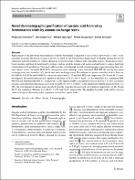| dc.contributor.author | Omwene, Philip Isaac | |
| dc.contributor.author | Öcal, Zehra Betül | |
| dc.contributor.author | Yağcıoğlu, Meltem | |
| dc.contributor.author | Karagündüz, Ahmet | |
| dc.contributor.author | Keskinler, Bülent | |
| dc.date.accessioned | 2023-02-23T13:58:29Z | |
| dc.date.available | 2023-02-23T13:58:29Z | |
| dc.date.issued | 2022-11-09 | |
| dc.identifier.citation | Omwene, P. I., Öcal, Z. B., Yağcıoğlu, M., Karagündüz, A., & Keskinler, B. (2022). Novel chromatographic purification of succinic acid from whey fermentation broth by anionic exchange resins. Bioprocess and Biosystems Engineering, 1-11. | en_US |
| dc.identifier.issn | 1615-7605 | |
| dc.identifier.uri | https://doi.org/10.1007/s00449-022-02805-w | |
| dc.description.abstract | Replacement of the petroleum-based refineries with the biorefinery is regarded as an essential step towards a “zero” waste (circular) economy. Biobased succinic acid (SA) is listed by the United States Department of Energy among the top ten chemicals with the potential to replace chemicals from petroleum synthesis with renewable sources. Purification of biobased succinic acid from fermentation by-products such as alcohols, formic acid, acetic acid and lactic is a major drawback of fermentative SA production. This study addresses this issue through a novel chromatographic separation using three distinct anionic resins: Amberlite IRA958 Cl (strong base anion exchange resin), Amberlite HPR 900 OH (strong base anion exchange resin) and Amberlyst A21 (week base anion exchange resin). The influence of process variables such as flow rate (0.18 BV/h, 0.42 BV/h and 0.84 BV/h), eluent concentration (1%, 5% and 10% HCl) and temperature (20, 30 and 40 °C) were investigated. The results indicated SA separation efficiency of 76.1%, 69.3% and 81.2% for Amberlyst A21, Amberlite HPR 900 OH and Amberlite IRA958 Cl, respectively. As the regenerant HCl concentration increased from 1 to 10%, calculated succinic acid separation efficiencies decreased from 80.3 to 70.7%. Notably, as the regenerant strength increased from 1 to 10%, the total amount of organic acids desorbed from the resin sharply increased. At operation temperatures of 20, 30 and 40 °C, SA separation efficacies were 81.2%, 73.9% and 76.4%, respectively. The insights from this study will be of great value in design of chromatographic separation systems for organic acids. | en_US |
| dc.description.sponsorship | Scientific and Technological Research Council of Turkey (TÜBITAK) | en_US |
| dc.publisher | Springer Nature | en_US |
| dc.subject | Succinic acid | en_US |
| dc.subject | Whey | en_US |
| dc.subject | Resins | en_US |
| dc.subject | Chromatography | en_US |
| dc.title | Novel chromatographic purification of succinic acid from whey fermentation broth by anionic exchange resins | en_US |
| dc.type | Article | en_US |

